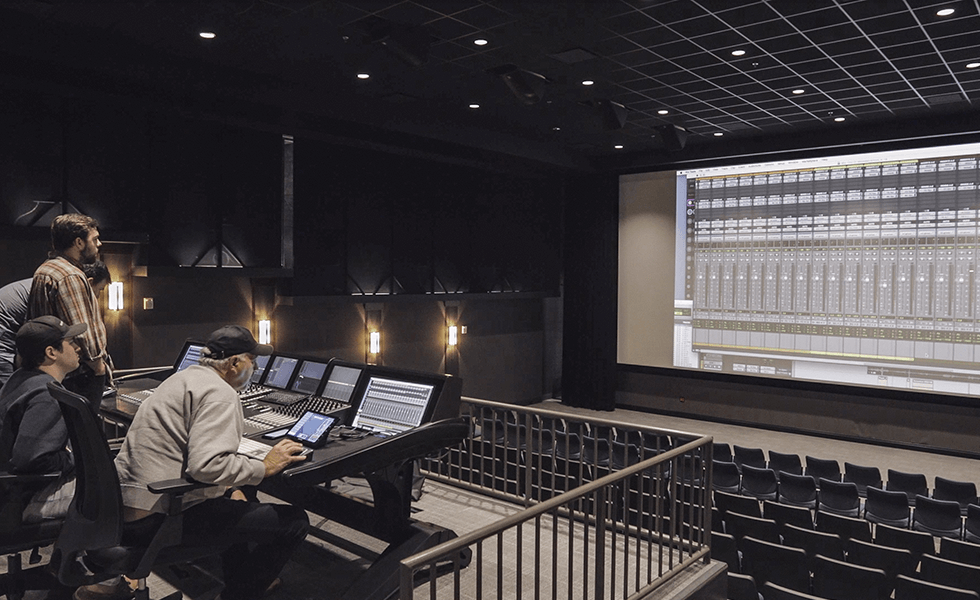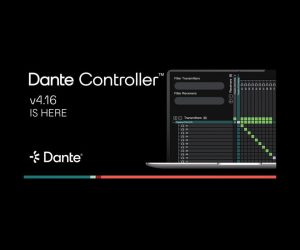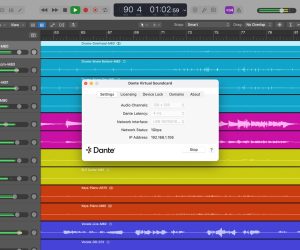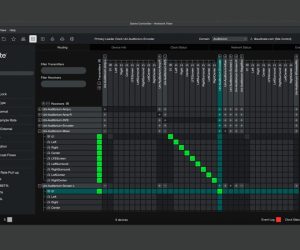
Dante & RedNet: A Case of Endless Possibilities for Belmont University
Belmont University’s Mike Curb College of Entertainment and Music Business is a music technology college like no other. The college covers music business, songwriting, audio engineering, motion pictures and media studies. It’s the largest college on campus with an average of 400 majors per year on the audio engineering program. The school, which started in the 1970s as a small department in the college of business, now has an impressive collection of performance spaces and production facilities, such as green-screen rooms, TV studios, an anechoic chamber, a foley/ADR suite and several music recording studios, plus their flagship 250-seat Dolby Atmos theatre, all of which are interconnected in a way that blows open the doors of possibility in terms of audio management. Many of these facilities are in the Johnson Center, which opened in 2015. The newness of the building plays a large part in Belmont’s present day technical capabilities: audio networks were integrated into the architectural plans for the building, such that audio is as central to the design of the building as any other utility.
Michael Janas, Chair of the Audio Engineering Technology department at Belmont, recalls the conditions before the Johnson Center was built. “We were running out of space, we were juggling a lot of stuff around. We had to expand,” he remarks. Senior Leadership at Belmont knew of the problems and, with the green light given for the new building, they approached the Curb College faculty with a proposition, “okay, envision it… what do you want out of this building?”
With an open-ended directive, the Audio Engineering Technology faculty began a discovery phase, which included trips to several film studios in California. They wanted to see for themselves what the commercial world was doing and, critically, what they wanted to be able to do in the future, from a technical standpoint. “We asked the studios ‘what do you wish you could do with your audio systems?'”
The Belmont team came back to Tennessee with a long list of responses from their commercial counterparts, which would come to influence what the completed Johnson Center would look like. One major suggestion from the pro community was to invest in Dolby Atmos, which at the time was a nascent surround audio format. As a result from this industry feedback, a large Dolby Atmos theater/soundstage and teaching space, with all the necessary, cutting-edge audio infrastructure, was added to the building specifications.
DANTE: FROM THE GROUND UP
The resounding suggestion, however, was to equip their facility with a next-generation audio-over-IP infrastructure, which could be expanded without needing to retrofit equipment. Running on off-the-shelf switches and standard Cat5e cabling, it was easy and affordable to lay the infrastructure for a building-wide system.
“In the fall of 2014, we were right in the middle of trying to figure out what we wanted, and then we started hearing about RedNet equipment and the Dante network,” recalls Michael Janas. So they put together a wishlist of RedNet equipment and started to plan it out. At this point, they brought on a new hire to lead the roll-out of the system. Ron Romano is the Technology Specialist at the College, whose role is not only to oversee the audio infrastructure and other AV systems, but also several hundred computers and other IT systems. His background made him the perfect fit for the Belmont job — as an experienced network engineer and former owner of an AV integration company, Ron had both the networking experience and audio chops needed for the job.
“We wanted to make sure that we had a facility that had a lot of great-sounding gear in the individual rooms, but also the ability to interconnect rooms and move audio around the facility,” says Ron. RedNet and Dante was the ideal solution. “From there, we started drawing a line diagram of what we were looking to put together.” Ron admits that he had no specific experience with RedNet equipment when he came to the school — at that time is was still a fairly new technology. “My first experience with RedNet and the Dante network was really that eye-opener that any tech would have. You’ve read about it, you’ve seen the videos; it almost sounds too good to be true until you initially fire it up!”
STAGING
The Dante network’s trouble-free setup process enabled Ron to quickly bring rooms online, even when the construction team were still working. “We asked the contractors to give us the keys to a room that was complete, and this became our temporary staging area for all the systems.” From their staging post, Ron and his team were able to configure, test and troubleshoot the various equipment racks that would be deployed in different rooms. In essence, they were able to set up the whole campus-wide system in one room, test it all working together, then deploy it across the building as soon as they got the opportunity. Dante Controller — the application that provides audio subscription control for all devices on the network — was critical to this phase, as was RedNet Control, free software for Mac and PC that allows control of all RedNet devices throughout a network from anywhere else on the network.
FULLY OPERATIONAL
In a short space of time, with the new academic year fast approaching, Ron and his team of student workers were able to bring the Johnson Center online and fully operational. There are a total of six facilities that have Dante equipment permanently installed, and they all have the ability to patch room-to-room, or all rooms together. The flagship Dolby Atmos theatre has a pair of Mac Pro computers with two RedNet 5 Pro Tools | HD Bridges, providing 32 channels of I/O on each side of the console. “RedNet 6s provide the MADI connection for the console, and out to the Dolby RMU, which is the box that does all the Dolby Atmos magic,” adds Ron. “We have a smaller 7.1 mix room, which is a similar setup to the large theatre minus the Atmos capabilities. In another rack room adjacent to the Foley/ADR suite, we have a set of RedNet 4 microphone preamps that students remotely control using RedNet Control. We’ve actually integrated the RedNet Control into the Pro Tools channel strip — it’s nice for a student to be in Pro Tools and actually control the preamps right inside the Mix window.” Apart from these permanent RedNet installations, the whole building is wired for Dante, so any space can be activated. Two rolling racks containing RedNet 2 A-D/D-A converters are on-hand to provide up to 80 channels of I/O to any corner of the campus with a network port.
Thanks to the simplicity and scalability of the RedNet gear, the Dante network and the other related systems — plus considerate planning by Ron and his colleagues — the Johnson Center today is abuzz with activity — and audio flying around the building on the Dante network. One of the best facets of the new system, remarks Ron, is that “it makes us look good!” Since the system went live, Ron’s experiences with the system have only improved. “It seems like, every time we put the [RedNet] stuff into a project, it just hits it out the park, everybody’s happy, the project looks great, everything sounds good. That’s what it’s all about. We just want to solve problems and get it done. Now that we’ve moved into an audio-over-IP system with the Dante network and the RedNet gear, the possibilities are endless, and we just continue to be blown away with its capabilities.”
REFLECTION
Since the Dante network and RedNet infrastructure was installed, the equipment has been used for many different applications. Once a year, the school hosts a major concert, entitled Best Of The Best, showcasing some of the best talents selected from four prior showcase concerts throughout the academic year. At the 2019 showcase, hosted in the Curb Event Center, the Dante network and the RedNet equipment enabled previously impossible capabilities, which the Audio Technology Department took full advantage of.
Audio from the FOH console was sent via MADI into a RedNet 6, and then over the Dante network via fibre-optics across campus to the Johnson Center. The Dante audio was accompanied by a program video feed from the arena, and simultaneously a live feed was sent to the Johnson Center TV studio, and to the 7.1 mix studio where a live recording session — in sonically isolated conditions — was conducted.
Looking back on these experiences, Ron reflects, “I don’t think we’d be able to do some of the things that we do if we didn’t have the Dante network and the RedNet equipment. Sure, there are always long ways to go analogue, but once you experience audio-over-IP and start to use it, you realise that this is the Swiss army knife you’ve been looking for.” As for the student experience, Ron comments on the breadth of systems the learners are exposed to during their time at Belmont. “I think it’s important that a student gets their hands on a little bit of everything as they go through the program. Now they can say ‘I know how to do audio-over-IP, and I’ve used Dante Controller and RedNet Control.’ That’s a huge benefit before they get out in the real world.”
Unsurprisingly, Belmont’s audio system is growing. At the time of writing, Belmont was in the planning stage for another new building, set for completion in 2020. Dante and the new line of RedNet interfaces will play a large role in the audio infrastructure, and a fibre-optic connection between the Johnson Center and the new building will physically expand the system and interlink the buildings.
Focusrite: focusrite.com
Australian Distributor: www.innovativemusic.com.au















RESPONSES